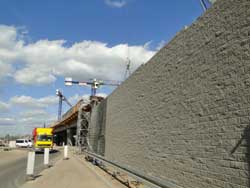Resisting Subsidence Pitfalls with TensarTech Retaining Wall Solutions
Extensive underground mining in south Poland posed a significant challenge to construction of the A1 motorway which forms part of the connection between the Czech border, Piekary Slaskie and on to northern Poland.

To accommodate potential differential settlement on the approach embankments to bridge structures, the engineering consultant consortium addressed the challenge by designing TensarTech™ soil retaining walls supporting the approach embankments to a series of viaduct and bridge structures along the 16km Piekary Slaskie to Pyrzowice (Katowice Airport) section. This approach ensured that any problems caused by previous land use were mitigated and the planned opening date of June 2012 was met.
“The A1 motorway project is highly important for improving the strategic transport infrastructure between South East Europe to the Baltic,” points out Dr Jacek Kawalec, Tensar Business Manager Europe. “However, the region south of Piekary has been extensively mined for coal, metal and minerals for centuries, with black coal still being extracted.
“As a result, there are extensive and often unknown tunnels, voids, weak spots, unconsolidated spoil heaps and other unstable sections. Unpredictable movement of the ground could cause great damage to a major road structure, and even threaten life.”
Use of conventional techniques such as piling to stabilise the ground and minimise the effects of any settlement would have been very costly. Instead, the engineering consortium Transprojekt Krakow and Complex Projekt Katowice put forward a TensarTech™ solution which had been previously proved in Poland as well as on another section of the motorway.
As the Piekary section of the A1 passes through a populated area, there are 17 connections with existing roads, using overpass bridges and viaducts, and one railway viaduct. Eight of these are constructed with TensarTech™ soil retaining structures which has the further advantage of using locally available aggregates, such as colliery spoil.
Adds Dr Kawalec: “Not only is suitable local material less expensive, and minimises transport miles, but it also reduces requirements for the import of high quality aggregates. The other major benefits of TensarTech™ solutions lie in the savings in time and plant. As there is no requirement to allow concrete to cure to full strength, for example, a structure can be loaded as soon as complete; this is very advantageous in complex large scale projects.”
Tensar geogrid reinforcement was laid back into the embankment, over which compacted, aggregate fill was laid to form the soil mass. The geogrid is securely connected by a polymer connector to a range of different dry laid wall facing components depending on the location and the required aesthetics. Finishes included TensarTech™ TW1 cast blocks, split face blocks, and octagonal concrete panels.
The retaining structures range from near vertical walls, to 60 degree sloping faces. The plan layout included a variety of curved faces which can be easily constructed without cutting the blocks, even on tight radius curves. The largest structure is 600 metres in length, ranging from 0.8 metres to 8.0 metres in height. Tensartech retaining wall systems have been used in numerous structures worldwide, frequently in seismically active areas, and the TW1 system is detailed in BBA certificate 99/R109.
Ends
Tensar International Ltd
Tel: 01254 262431
Email: sales@tensar.co.uk
Web: http://www.tensar.co.uk
Original of this article here
